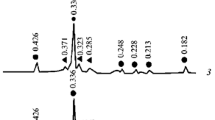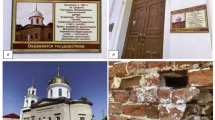Clinker brick was obtained on the basis of polymineral raw materials, including low-melting and refractory clays, loams, and granitoid screenings in the plastic method of manufacturing. The interrelation of the physical and chemical properties of products was determined as a function of the mass content of the components and the oxide composition of the charge, and the optimal temperature_time regimes of firing were determined — 1150 ± 5°C with exposure of 4 h at an optimal temperature. The data obtained on the oxide and mineral composition make it possible to predict the composition of the charge for producing clinker brick, the heat-treatment regimes, and the properties of the products.




Similar content being viewed by others
Notes
Hereinafter in the text, unless otherwise stated, the weight content, %, is indicated.
References
1. S. V. Morozova, E. N. Permyakov, A. V. Karnilov, et al., “Clinker brick based on local low-melting raw materials,” Vest. Kazan. Tekhnol. Univ., No. 5, 24 – 26 (2010).
V. V. Koleda, E. S. Mikhailyuta, E. V. Alekseeva, et al. “Technological features of clinker brick production,” Glass Ceram., 66(3 – 4), 132 – 136 (2009) [Steklo Keram., No. 4, 17 – 20 (2009)].
L. Krakow, “Versatzoptimierung mit regionalen TonenRohstoffkonzepte und Tongrubenatlas Clayserver,” Zigel Zeitschriff., No. 5, 294 – 298 (2000).
A. I. Avgustinik, Ceramics [in Russian], Stroiizdat, Leningrad (1975), pp. 53 – 75.
A. Tatarin and R. Vog, “Untersuchungen für grobkeramische Rohstoffe. Teil 1: Rohstoffzusammensetzung (primäre Eigenschaften),” Zigelindustrie Int., 66(4), 20 – 34 (2013).
S. Vogt, “Methoden zur Bewertung der Rohstoffeignung und Masseoptimierung. Teil 1,” Zigelindustrie Int., 68(5), 34 – 43 (2015).
I. A. Levitskii and O. N. Khoruzhik, “Investigation of the sintering of a multicomponent raw mixture based on mineral raw materials from Belarus,” Tr. BSTU, Ser. 2, No. 2, 140 – 145 (2018).
E. S. Khomenko and A. V. Pudrik, “Particulars of microstructure formation in clinker ceramic,” Glass Ceram., 74(1 – 2), 48 – 51 (2017) [Steklo Keram., No. 2, 15 – 19 (2017)].
Author information
Authors and Affiliations
Corresponding author
Additional information
Translated from Steklo i Keramika, No. 5, pp. 26 – 33, May, 2021.
Rights and permissions
About this article
Cite this article
Levitskii, I.A., Khoruzhik, O.N. Relationship of Properties, Phase Composition, and Microstructure of Clinker Brick. Glass Ceram 78, 193–199 (2021). https://doi.org/10.1007/s10717-021-00377-x
Published:
Issue Date:
DOI: https://doi.org/10.1007/s10717-021-00377-x




